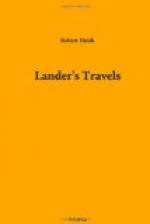After a painful route of sixteen days through this solitary region, the travellers were cheered by seeing before them the great oasis, or small kingdom of Fezzan. Both at Temissa, the first frontier town, and at Zuila, the ancient capital, which is still inhabited by many rich merchants, they were received with rapturous demonstrations of joy. The arrival of a caravan is the chief event which diversifies the existence of the Fezzaners, and diffuses through the country animation and wealth. At Mourzouk, the modern capital, the reception was more solemn and pompous. The sultan himself awaited their arrival on a small eminence, seated in an arm chair, ornamented with cloth of various colours, and forming a species of throne. Each pilgrim, on approaching the royal seat, put off his sandals, kissed the sovereign’s hand, and took his station behind, where the whole assembly joined in a chant of pious gratitude.
Fezzan, according to Horneman, has a length of 300, and a breadth of 200 miles, and is much the largest of all the oases, which enliven the immense desert of Northern Africa. It relieves, however, in only an imperfect degree, the parched appearance of the surrounding region. It is not irrigated by a river, nor even a streamlet of any dimensions; the grain produced is insufficient for its small population, supposed to amount to 70,000 or 75,000 inhabitants, and few animals are reared except the ass, the goat, and the camel. Dates, as in all this species of territory, form the chief article of land produce, but Fezzan derives its chief importance from being the centre of that immense traffic, which gives activity and wealth to interior Africa. Mourzouk, in the dry season, forms a rendezvous for the caravans proceeding from Egypt, Morocco and Tripoli, to the great countries watered by the western river. Yet the trade is carried on less by the inhabitants themselves, than by the Tibboos, Tuaricks, and other wandering tribes of the desert, concerning whom Horneman collected some information, but less ample than Lyon and Denham afterwards obtained from personal observation. Of Timbuctoo, he did not obtain much information, Morocco being the chief quarter whence caravans proceed to that celebrated seat of African commerce. In regard, however, to the eastern part of Soudan, he received intelligence more accurate than had hitherto reached Europe. Houssa was for the first time understood to be, not a single country or city, but a region comprehending many kingdoms, the people of which are said to be the handsomest, most industrious, and most intelligent in that part of Africa, being particularly distinguished for their manufacture of fine cloths. Amongst the states mentioned, were Kashna, Kano, Daura, Solan, Noro, Nyffe, Cabi, Zanfara and Guber. Most or all of these were tributary to Bornou, described as decidedly the most powerful kingdom in central Africa, and which really was so regarded before the rise of the Fellatah empire caused




